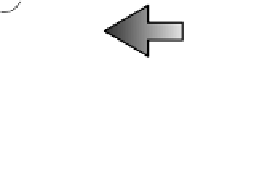Geoscience Reference
In-Depth Information
forces are acting and stresses are developed. If only gravity
force is applied, our expectation from the fluid state is that
the weight of the column of rock mass over the point-cube
should give a state of hydrostatic stress at the point. In the
case of solid rocks, this stress state is called
lithostatic stress
or
confining pressure, and corresponds to the force per unit
area produced by the weight of a column of rock due to the
gravity force. However, there are
always
other forces at
work in the Earth and the lithostatic stress state is a rare in
rigid solids. In fact, the vertical stress, a compressive stress
due to gravitational loading, affects the horizontal stresses
as rocks tend to expand perpendicularly to applied compres-
sion. We will discuss this point further when we consider
rheological properties of solid deformation (Section 3.15).
?
s
z
z
s
xo
= 20 MPa
?
65º
s
x
A
3
y
A
2
A
1
o
x
A
1=
n
m
2
(
n
is on the order of
10
-12
m
2
)
(2)
A
3=
A
1 cos 65º
(3)
A
2=
A
1 sin 65º
s
oz
= 30MPa
Fig. 3.61
3D view of the stress components acting over a triangular
prism in two directions.
3.13.2
Magnitude of the stress tensor in the Earth
It is useful at the outset to have an idea of the magnitude of
stress in the crust. For example, if we consider a mass
of static granite, density
F
zo
2,700 kg m
3
, at a depth,
h
, of
1,000 m, the lithostatic load per unit area should be
gh
, which gives 26.5 MPa. This lithostatic load is
responsible for the vertical compressional stress and should
increase linearly with depth due to the increasing weight of
the rock itself over progressively deeper surface areas. To try
to understand how the stress tensor is constructed and
which are the magnitude and orientation of the individual
tractions acting upon different surfaces on a small volume of
this granite rock we can analyze the stress in 2D with
unequal values for the normal tractions acting parallel to the
vertical
z
-axis (
F
ox
F
xo
65º
F
xo
=
F
ox
F
zo
=
F
oz
F
oz
zo
and
oz
), and the horizontal
x
-axis (
xo
and
ox
). Assuming that the point-cube is located at a depth
of about 1.1 km in the crust, the value of the vertical trac-
tion will be roughly 30 MPa and will correspond to the ver-
tical compressional loading in granite rocks. We now
arbitrarily take the horizontal traction acting over the center
of the cube to be less than the vertical, say 20 MPa. In order
for this situation to exist some external force must operate.
Now let an inclined surface cut the cube so that a trian-
gular prism is developed. Let this surface be defined by an
angle with respect to the vertical axis
z
, for example 65
(4)
F
=
s
.
A
s
xo
.
A
3 = 20 MPa
nm
2
cos 65º (N)
(6)
F
ox
=
(5)
F
xo
=
s
x
MPa
nm
2
(N)
s
x
.
A
1=
(Fig. 3.61). To simplify things we can call this inclined sur-
face
A
1;
A
2 is then the surface parallel to the horizontal
plane
xy
and
A
3 to the surface parallel to the vertical plane
zy
. Remember that all these surfaces have to be very small,
of order 10
12
m
2
or less as the stress state is now only rep-
resentative of a single point in the mass of rock (stress gra-
dients will occur along any larger finite rock volume). We
can now relate all the surfaces as a function of
A
1 using sim-
ple trigonometric relations (Equations 2 and 3; Fig. 3.61).
(7)
s
x
=
s
xo
cos 65º = 20 MPa
0.42 = 8.4 MPa
Similarly:
(8)
s
z
=
s
oz
sin 65º = 30 MPa
0.91 = 27.2 MPa
Fig. 3.62
Frontal view of the prism showing forces in equilibrium.
In any state of static equilibrium, forces have to be bal-
anced so the prism does not move or rotate; the horizontal
forces
F
ox
and
F
xo
have to be balanced so that
F
ox
F
xo
and
similarly the vertical forces so that
F
oz
F
zo
(Fig. 3.62).



















Search WWH ::

Custom Search